The safety of your child is of the highest importance as a parent. You want to protect them from harm and keep them healthy. One way to do this is by teaching them first aid skills. First aid is the initial help given to an injured or sick person before professional medical care arrives.

Online first aid certification[1] can help your child learn the skills and knowledge necessary to provide first aid in an emergency. Taking a first aid course from the American HealthCare Academy is particularly beneficial for young children.
What are the components of a first aid kit?
A first aid kit is a collection of essential items used to provide initial care for an injury or illness. The components of a first aid kit can vary, but some common items include:
- Adhesive bandages of different sizes
- Sterile gauze pads and adhesive tape
- Antiseptic wipes or spray
- Disposable gloves
- Scissors and tweezers
- Instant cold pack
- Blanket
- First aid manual
Children and their understanding power
Children have a natural curiosity about their surroundings, and they love to explore. This makes them more prone to injuries and accidents. Teaching children about first aid and how to put together a first aid kit can be a lifesaving skill. However, it is essential to consider the child’s age and understanding power when teaching them first aid skills.
Younger children may not be able to understand complex first-aid techniques or how to use certain first-aid items. Therefore, it is crucial to keep the first aid instructions simple and easy to follow.
How to teach your child about first aid?
Teaching children about first aid can be a fun and interactive experience. Here are some tips to help you teach your child about first aid:
- Start with the basics: Teach your child about the components of a first aid kit and what each item is used for.
- Use visual aids: Use pictures and videos to help your child understand how to use each item in the first aid kit.
- Role-play: Role-play different scenarios with your child, such as how to help someone who has fallen or what to do if someone is choking.
- Make it fun: Incorporate games and quizzes into your teaching to make it more engaging for your child.
- Keep it simple: Use simple language and avoid complex medical terminology that may confuse your child.
- Use real-life examples: Talk about real-life examples where first aid was necessary and how it helped the person in need.
- Emphasize the importance of calling for help: Teach your child the importance of calling 911 or seeking professional medical help in case of a serious emergency.
- Practice regularly: Practice different first aid scenarios with your child regularly to reinforce their learning.
- Encourage questions: Encourage your child to ask questions and provide them with accurate and age-appropriate answers.
By following these tips, you can help your child develop the skills and knowledge necessary to provide basic first aid in an emergency. Remember to keep it simple, fun, and engaging, and always emphasize the importance of seeking professional medical help when needed.
Knowledge is power and a friend in adversity
Knowledge is power, and when it comes to first aid, it can be a lifesaving tool in an emergency. First aid knowledge can provide you with the skills and confidence necessary to provide immediate care to someone who is injured or sick. By knowing how to properly administer first aid, you can potentially save a life or prevent further injury.
In addition to providing immediate care, first aid knowledge can also be a friend in adversity. Accidents and emergencies can happen at any time and in any place, and being prepared can provide peace of mind. Having a first aid kit and the knowledge to use it can help you feel prepared and in control in case of an emergency.
Overall, first aid knowledge is a valuable tool to have, and it is never too early or too late to learn. Whether you are a parent, caregiver, or just someone who wants to be prepared, taking the time to learn basic first aid skills can make all the difference in an emergency.
If you want to learn more about first aid, you can take an online first aid certification[2] course from AHCA. The courses can provide you with the knowledge and skills necessary to respond to an emergency. They cover topics such as CPR, bleeding control, and first aid for different injuries and illnesses.
keyword
keyword

